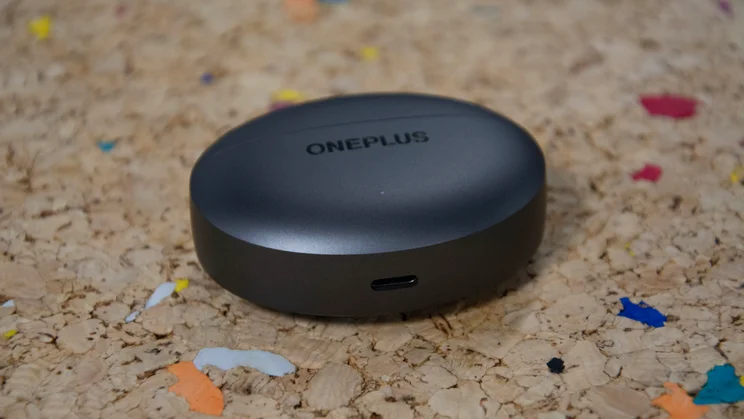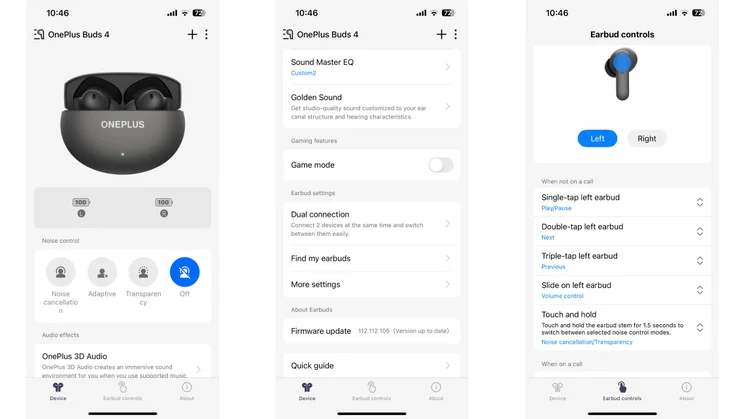To help us provide you with free impartial advice, we may earn a commission if you buy through links on our site. Learn more










- Lightweight, comfortable design
- Impressive ANC
- Hi-Res Audio and spatial audio support
- Middling battery life
- No wireless charging
- Touch control and app frustrations
OnePlus may be best known for its smartphones, but it invests significant resources into creating headphones to complement its handsets.
The OnePlus Buds 4 are its latest wireless earbuds and tick a lot of boxes at a very reasonable price. They may not bring anything particularly groundbreaking to the table, but they will serve you well if you own an Android phone.
What do you get for the money?
The OnePlus Buds 4 have a list price of £119, but were available for £99 in either Zen Green or Storm Grey at the time of writing. Given their impressive specification and range of features, that looks like great value for money.
These traditional stem-style earbuds are IP55-rated for dust and water resistance, have twin 11mm and 6mm drivers, and support Bluetooth 5.4, along with Hi-Res Audio streaming up to 24-bit/192kHz courtesy of the LHDC Bluetooth codec.










There’s a proprietary, content-agnostic spatial audio mode using OnePlus’ proprietary 3D Audio algorithm, sound personalisation in the form of the brand’s Golden Audio hearing test technology, and noise-cancelling and transparency modes for managing the varying demands of your external environment.
You also get a full suite of touch controls, customisable via the Hey Melody companion app. This also provides access to EQ presets, a seven-band graphic equaliser, “BassWave” slider, and low-latency Game mode.










In the box, OnePlus supplies three different sizes of eartips, along with a short USB-C cable for charging the case. That pebble-shaped case holds three full charges, which themselves will last around six hours with ANC on and 11 hours with it off. So, you’re looking at roughly 24 hours of moderate-volume listening with ANC on and 45 hours with it off.
What do they do well?
Let’s start with noise cancellation. Affordable earbuds are becoming increasingly capable in this department, but the Buds 4 overperform for the money. You’ve got three noise control modes at your disposal: Noise Cancellation, Adaptive and Transparency. The former comes in four flavours (High, Moderate, Low and Auto), with the latter shifting between the other three settings based on the level of ambient noise.
While I took issue with the level the Auto mode selected on occasion, I was very impressed by the amount of noise attenuated by the highest setting. Traffic on the high street, the rumble of trains and fan noise from my laptop were all considerably more bearable with the Buds 4 in my ears. ANC doesn’t detrimentally impact sound quality either, which is always a relief. However, I did notice a faint hiss when there wasn’t any audio playing and ANC was engaged. The transparency mode works well enough to give you a useful sense of what’s going on in your surroundings, too.










The Buds 4 get the fit just right. They’re lightweight and nestled in my ears very comfortably, meaning I was able to wear them for extended periods without issue. They remained snug and stable during exercise, and their IP55 dust and water resistance rating certifies them as better protected against the elements than popular alternatives, including the Sony WF-C710N and Nothing Ear (a). The charging case is pleasingly pocketable, and the lid snaps open and shut smartly, reflecting a reassuring level of build quality.
The dual-driver setup is pretty advanced for this kind of money, and the resulting audio quality is a cut above most £100 earbuds. The 11mm woofers managed to deliver the pumping low-end frequencies on BlasterJaxx’s Bass Don’t Lie in a forthright manner, reaching deep down into the sub-bass realm while remaining nicely defined in the mid-bass region.










Feed them Hi-Res Audio over LHDC, and they demonstrate keen powers of articulation further up the frequency spectrum. Joni Mitchell’s high notes on All I Want hit cleanly, and her fluctuations in tone and tempo were communicated skillfully. The Buds 4 are well-balanced, too, although only with the BassWave setting disabled. This slider dynamically boosts low-end frequencies “to deliver deep bass with clarity and fidelity”, but I found it swamped the mid-range somewhat. Even at its moderate 0 setting (the slider ranges from Weak -5 to Strong 5), bass muscled in slightly too much for my liking on the acoustic version of Ace of Base’s Lucky Love.
Proprietary spatial sound modes vary wildly in effectiveness. I’m a big fan of Bose’s Immersive Audio on the QuietComfort Ultra Earbuds 2nd Gen, but Nothing’s take on it added very little to the Headphone (1). OnePlus’ 3D Audio works well. Engaging it on the aforementioned Ace of Base track broadened the soundstage significantly and made the track sound more dynamic, albeit less cohesive. I’d equate it to watching your TV in Dynamic mode instead of the more accurate Filmmaker or Movie mode. We all know the latter provides a more neutral, accurate presentation, but sometimes we crave a more visceral feeling, and the spatial sound mode here provides that.
What could be improved?
I appreciate the inclusion of Adaptive noise-cancelling, which switches between noise cancellation and transparency automatically, but it’s very slow to react when moving between noisy and quieter environments. My advice would be to take the proactive option and manually switch between ANC and transparency when required.
Doing so is simple using the Buds 4’s touch controls. Hold your finger on the stem of either bud, and it will cycle between the two. However, I found executing some of the other touch controls – the swipe gesture for volume control in particular – a little frustrating. I found I had to be very deliberate with my finger movements to avoid accidentally pausing audio instead. I also hit a few snags with the Hey Melody app, which occasionally proved unresponsive and laggy when switching between ANC settings.










I also felt that call quality could be better. They pick up quite a bit of background noise, and there was an unwanted echoey quality to my voice. People were still able to understand what I was saying, but my speech could have sounded more natural.
Another area in which the Buds 4 reflect their price point is design. Build quality is perfectly acceptable, and they’re super comfy, but these are some of the most generic and bland-looking earbuds around. It’s hard to argue with OnePlus prioritising function over form, given what it’s charging, and wireless earbuds don’t always have to look snazzy, but, in the Storm Grey colourway I tested, the Buds 4 are drab.
My final gripes concern the absence of wireless charging and middling battery life. The former is a premium feature that has steadily made its way down to more affordable in-ear options, so I’m a little surprised it’s not here. And battery life (six hours) falls well short of the Sony WF-C710N, which last for 8hrs 30mins with ANC on.
Should you buy the OnePlus Buds 4?
My small niggles with the OnePlus Buds 4 add up to them losing a star, but their effective noise cancellation, strong audio quality, Hi-Res and spatial audio support, and comfortable design are more than enough to earn them a recommendation.
That said, if you’re not fussed about spatial audio, I suggest choosing either the Cambridge Audio Melomania A100 or Sony WF-C710N instead. The A100 beat the Buds 4 for sound quality, codec support and battery life, and support wireless charging, too. The Sony WF-C710N, meanwhile, aren’t Hi-Res Audio certified, but still sound fantastic, are incredibly comfortable, better for calls, and have smarter adaptive ANC.







